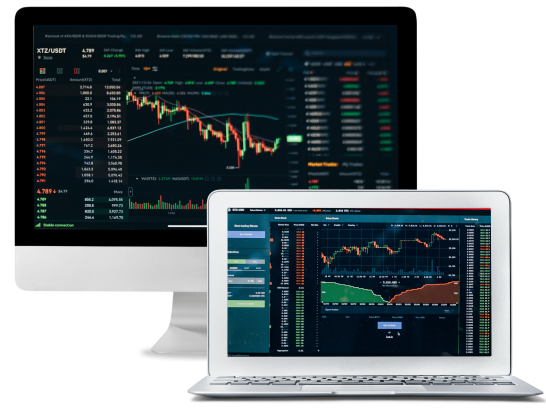Benefits of trading stocks
Profitability
They are investments that have great potential in the long term.
Diversification
They allow exposure to different businesses and markets.
Liquidity
You can quickly access your funds if you need them.
What stocks can I invest in?
Access all quotes in real time, and choose the one that best suits your objective.
Potential your opportunities
In the Research section you will find all the reports to optimize your decisions.
FAQs
Shares are securities that represent a portion of the company's capital stock, so it is understood that whoever purchases them becomes a shareholder or partner of the company. The issuance of shares allows the company to raise capital by selling them to face new investments, and therefore, constitutes a form of financing. It is important to note that stocks are considered variable income assets. The latter implies that its profitability is not pre-established.
There are two sources of profits when investing in stocks. One is the capital gain represented by the rise in the price of the stock. Price that in the market will be influenced by various factors of its own - such as expectations about the future profit of the company, its sales, its growth, etc. - as well as external to the company itself or even its sector. Among them are expectations regarding economic developments and investor confidence, and the evolution of different financial and economic variables such as interest rates, inflation, exchange rates, etc. Over time, however, it is understood that its value will depend mainly on the performance of the company and the development of the economic sector to which it belongs. Meanwhile, the other source of potential profits will be dividends. Specifically, the dividend will be the result of the distribution of the profits - if any - that it is decided to distribute at the end of the company's fiscal year. It is an economic right that grants each share to be collected in the distribution of profits for the year. However, companies are not required to pay dividends.
Companies can decide to distribute different types of dividends. In cash: It is the payment in money of the profit for the year to be distributed in proportion to the participation in the share capital. In shares: It is the payment in kind (shares) of the profit for the year to be distributed in proportion to the participation in the share capital. It implies a capitalization of profits, since in accounting terms the company transfers resources from Accumulated Results to Capital. The payment of dividends in shares does not modify the equity, but increases the number of shares.
There are different types of shares that can be authorized for public offering. Among them, we distinguish: Ordinary shares: They generally grant the right to vote and have economic rights in equal proportion to their participation in the share capital. Preferred shares: They grant an economic preference or preferential collection dividends with respect to ordinary shares. Generally, they do not have the right to vote. Redeemable shares: Their total or partial purchase by the issuer or a third party is established in the issuance conditions. There are also participation actions, scriptural actions, etc. They can also be classified by the rights they grant in the event of a capital increase, such as, for example, preferential subscription or accretion rights.
There are basically two ways to acquire shares. One is in the secondary market – through purchase on the market. This is where the purchase/sale of the different financial assets that have been issued and have a public offer are negotiated. Another way is to buy in the primary market. It is the acquisition at the time of its issuance according to the conditions established in the issuance prospectus. This process is known as IPO (Initial Public Offering), or it can be carried out privately.
All financial assets carry different risks. Investing in stocks is no exception. It presents risks derived from the company itself, or the market in general, and the local or external economic situation. Among some of them, we can identify: Market, or systemic, risk: It is associated with the volatility of the market in general, related to economic cycles, political conditions and trends that affect market movements, accentuating the risk. Commercial risk: Risk associated with the evolution of the company's main or secondary business. This can be affected for different reasons. Inflation risk: If over time the inflation rate is higher than the return generated by the investment, it will have less purchasing power. However, it is believed that in stocks, unlike other assets, this risk is minimized. Interest rate risk: Arises from the sensitivity that the value of your investments may have to fluctuations in interest rates.
All companies prepare with a certain frequency – established by law – a general balance sheet that contains all of the company's accounting and financial information. One way to analyze the balance sheets, which will allow us to know the economic and financial situation of the company, is through certain ratios or indicators. These not only serve to compare the company's performance against previous periods, but also against companies in the same sector. Financial indicators can be classified into at least four groups: 1. Liquidity indicators; 2. Operational or activity indicators; 3. Debt indicators; 4. Profitability indicators. The former measure the availability or solvency of cash, or the company's ability to pay its short-term obligations. The latter allow us to establish the degree of efficiency with which the company's administration manages resources and their recovery. Third parties, for their part, help determine the company's debt level. While profitability ratios comprise a set of indicators and measures whose objective is to measure how profitable the company is. Among the most relevant, at this point, we find the ROA, ROE, EPS, etc.



